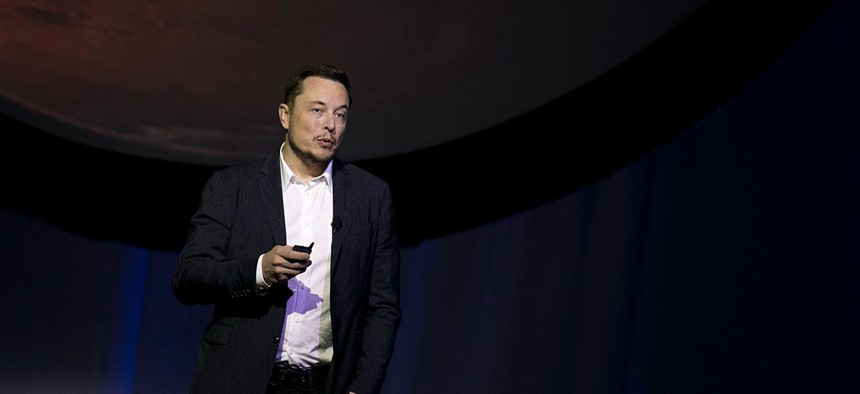If The U.S. Really Wants To Go To Mars, Elon Musk Knows How To Bring Down The Price
It would take a little old-fashioned competition and a lot less government control.
“Our nation will return to the moon and we will put American boots on the face of Mars,” US vice president Mike Pence, newly ensconced as the head of the National Space Council, said last week in a speech at NASA’s Kennedy Space Center.
The only problem? The US government’s plan to do this relies on an building an expensive rocket and spacecraft that is scheduled to only fly once a year. That’s been a drain on resources that has delayed design and construction of other needed ingredients, like the habitat to carry astronauts between celestial bodies or the technology to land a vehicle laden with humans and supplies on another planet.
“I can’t put a date on humans on Mars, and the reason really is … we don’t have the surface systems available for Mars,” NASA human exploration chief William Gerstenmaier said on an engineering society panel this week. “And that entry, descent, and landing is a huge challenge for us for Mars.”
To help figure out the landing challenge, NASA scientists have been working with Elon Musk’s company SpaceX, which operates rockets that do things like return to Earth and safely land using rocket engines. The data gathered from these flights is helping engineers understand how to land on Mars. NASA is supporting SpaceX’s plan to send one of its Dragon spacecraft to the planet—which, should they succeed, would be the heaviest object ever sent from Earth to Mars.
In a hearing yesterday (July 13), SpaceX senior vice president Tim Hughes proposed that NASA, alongside its own heavy space rocket, kickstart a new public-private program akin to the one that allowed SpaceX to develop its rocket and NASA to send supplies to the International Space Station, arguing that it is the most cost effective way to achieve US goals in space.
That program, the Commercial Orbital Transportation Services, or COTS, was put together by a team within NASA that was frustrated with the slow pace and cost overruns of traditional contractors tasked with replacing the retiring Space Shuttle. In 2006, they began a competitive process that ended in 2012 with two companies, SpaceX and OrbitalATK, contracted to fly supplies to the International Space Station at fairly low cost.
While COTS suffered from its own delays, the return on investment was impressive for a NASA program: The $500 million investment resulted in the creation of two new rockets, SpaceX’s Falcon 9 and OrbitalATK’s Antares. While the Antares has suffered from growing pains following an early failure, the Falcon 9 has proven a cost-effective and reliable vehicle for NASA projects. On the other hand, NASA’s deep-space rocket—an admittedly more complex challenge—has been under development since 2010, will cost $23 billion, and won’t fly until 2019.
The difference is in the construction of the contracts. The COTS programs were based on competition, and on fixed prices linked to milestones rather than a guaranteed profit for contractors. The rocket builders were assigned broad performance goals rather than strict requirements, and contractors were required to make significant investments of their own. While this public-private partnership model arguably gives NASA less control over the final product, it creates stronger incentives for innovation and on-time delivery.
Hughes and SpaceX argued that NASA should create a deep-space equivalent of COTS, allowing private companies to bid on contracts to develop powerful rockets to voyage to the moon or Mars, spacecraft and habitats to carry humans and supplies, or sophisticated communications networks to keep everyone in touch. “The principles applied in past programs for low Earth orbit capability can and should be applied to deep-space exploration,” Hughes argued in his testimony.
SpaceX wouldn’t be the only potential beneficiary. It’s likely that Blue Origin, Jeff Bezos’s space company, would also seek to participate. More traditional aerospace contractors like Lockheed Martin or Boeing are invested in the new deep-space rocket, but could also seek to compete for a hypothetical partnership.
This proposal was foreshadowed last year in Guadalajara, Mexico. At the International Astronautical Congress there, Musk presented a sketch of the architecture needed to lower the cost of transit to Mars enough to make colonization feasible. His top-line cost of $10 billion, however, is likely out of reach for SpaceX in the near term—without the help of a big-pocketed government.
“There’s a lot of people in the private sector who are interested in helping fund a base on Mars, and perhaps there will be interest on the government sector side to do that,” Musk said last fall.
It might seem brash of Musk to propose that his young firm shuttle the world’s premiere space agency to its next planet. But it’s hard to imagine a more cost-effective model.




